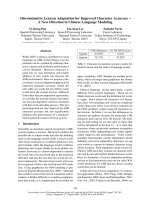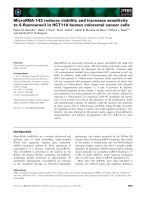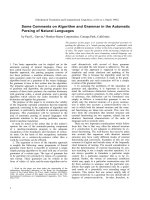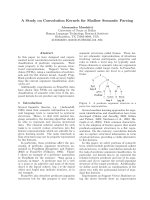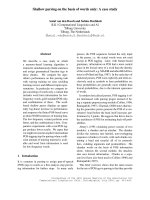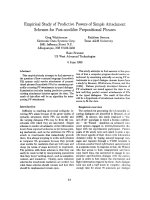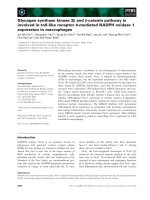Báo cáo khoa học: "Multicentre study on peri- and postoperative central venous oxygen saturation in high-risk surgical patients" pptx
Bạn đang xem bản rút gọn của tài liệu. Xem và tải ngay bản đầy đủ của tài liệu tại đây (375.57 KB, 8 trang )
Open Access
Available online />Page 1 of 8
(page number not for citation purposes)
Vol 10 No 6
Research
Multicentre study on peri- and postoperative central venous
oxygen saturation in high-risk surgical patients
Collaborative Study Group on Perioperative ScvO2 Monitoring
Received: 5 Jul 2006 Revisions requested: 27 Jul 2006 Revisions received: 30 Aug 2006 Accepted: 13 Nov 2006 Published: 13 Nov 2006
Critical Care 2006, 10:R158 (doi:10.1186/cc5094)
This article is online at: />© 2006 Collaborative Study Group on Perioperative ScvO2 Monitoring; licensee BioMed Central Ltd.
This is an open access article distributed under the terms of the Creative Commons Attribution License ( />),
which permits unrestricted use, distribution, and reproduction in any medium, provided the original work is properly cited.
For a complete list of authors and their affiliations, see Appendix. Corresponding author: Stephen M Jakob
Abstract
Introduction Low central venous oxygen saturation (ScvO
2
) has
been associated with increased risk of postoperative
complications in high-risk surgery. Whether this association is
centre-specific or more generalisable is not known. The aim of
this study was to assess the association between peri- and
postoperative ScvO
2
and outcome in high-risk surgical patients
in a multicentre setting.
Methods Three large European university hospitals (two in
Finland, one in Switzerland) participated. In 60 patients with
intra-abdominal surgery lasting more than 90 minutes, the
presence of at least two of Shoemaker's criteria, and ASA
(American Society of Anesthesiologists) class greater than 2,
ScvO
2
was determined preoperatively and at two hour intervals
during the operation until 12 hours postoperatively. Hospital
length of stay (LOS) mortality, and predefined postoperative
complications were recorded.
Results The age of the patients was 72 ± 10 years (mean ±
standard deviation), and simplified acute physiology score
(SAPS II) was 32 ± 12. Hospital LOS was 10.5 (8 to 14) days,
and 28-day hospital mortality was 10.0%. Preoperative ScvO
2
decreased from 77% ± 10% to 70% ± 11% (p < 0.001)
immediately after surgery and remained unchanged 12 hours
later. A total of 67 postoperative complications were recorded
in 32 patients. After multivariate analysis, mean ScvO
2
value
(odds ratio [OR] 1.23 [95% confidence interval (CI) 1.01 to
1.50], p = 0.037), hospital LOS (OR 0.75 [95% CI 0.59 to
0.94], p = 0.012), and SAPS II (OR 0.90 [95% CI 0.82 to 0.99],
p = 0.029) were independently associated with postoperative
complications. The optimal value of mean ScvO
2
to discriminate
between patients who did or did not develop complications was
73% (sensitivity 72%, specificity 61%).
Conclusion Low ScvO
2
perioperatively is related to increased
risk of postoperative complications in high-risk surgery. This
warrants trials with goal-directed therapy using ScvO
2
as a
target in high-risk surgery patients.
Introduction
Several randomised controlled clinical studies have shown
improved morbidity and mortality in high-risk surgical patients
with perioperative optimisation of haemodynamics using strict
treatment protocols in the single-centre setting [1-3]. The
haemodynamic endpoints in goal-directed studies have been
based on values derived from the pulmonary artery catheter [1-
4], oesophageal Doppler [5-10], or (very recently) lithium indi-
cator dilution and pulse power analysis [11]. Central venous
oxygen saturation (ScvO
2
) and mixed venous oxygen satura-
tion (SvO
2
) have been proposed to be indicators of the oxygen
supply/demand relationship. However, the relationship
between SvO
2
and ScvO
2
remains controversial [12]. Venous
oxygen saturations differ among organ systems because dif-
ferent organs extract different amounts of oxygen. It is there-
fore conceivable that venous oxygen saturation depends on
the site of measurement [13]. Redistribution of blood flow and
alterations in regional oxygen demand (for example, in shock,
severe head injury, general anaesthesia, as well as microcircu-
latory disorders) may affect the difference between ScvO
2
and
SvO
2
. Although ScvO
2
principally reflects the relationship of
oxygen supply and demand, mainly from the brain and the
upper part of the body [13], it correlates reasonably well with
concomitantly measured SvO
2
[12,13], which is more
dependent on changes in oxygen extraction in the gastrointes-
tinal tract.
HDC = high-dependency care; ICU = intensive care unit; LOS = length of stay; OR = odds ratio; ROC = receiver operator characteristic; SAPS II
= simplified acute physiology score; ScvO
2
= central venous oxygen saturation; SvO
2
= mixed venous oxygen saturation.
Critical Care Vol 10 No 6
Page 2 of 8
(page number not for citation purposes)
In patients with severe sepsis and septic shock, early ScvO
2
-
driven haemodynamic treatment was found to reduce mortality
[14]. More recently, low postoperative ScvO
2
values were
associated with an increased risk of complications in high-risk
surgical patients [11]. Despite increasing evidence of benefi-
cial effects on outcome, goal-directed therapies are not widely
used in clinical practice. The reasons are a lack of demon-
strated effect in large multicentre studies, the need for postop-
erative intensive care resources, the necessity of instituting
complex protocols, as well as the need for monitoring tech-
niques that are not routinely used in these specific patient
groups. Using the ScvO
2
as a potential target variable for
haemodynamic optimisation is attractive because central
venous catheterisation is routinely used in high-risk patients
undergoing major surgery, ScvO
2
can be screened, pre-emp-
tive treatment is possible, and no major changes are neces-
sary for the infrastructure in the operation area.
The present investigation was a pilot study designed to assess
the incidence of low perioperative ScvO
2
in high-risk surgical
patients and the association of low ScvO
2
with outcome in a
multicentre setting. The aim was to evaluate whether the asso-
ciation of ScvO
2
and postoperative complications in a strictly
protocolised, interventional single-centre study on goal-
directed haemodynamic management in high-risk surgical
patients [11] could be confirmed in a purely observational,
multicentre setting. Specifically, this pilot study was designed
to clarify (a) the recruitment rate of patients scheduled for
major surgery in a multicentre setting, (b) the range of periop-
erative ScvO
2
in such patients, (c) the number of postopera-
tive complications, and (d) the potential association between
ScvO
2
and complications. With these data, it should be possi-
ble to define whether a trial with goal-directed therapy using
ScvO
2
as a target is reasonable to conduct.
Materials and methods
Two university hospitals in Finland and one in Switzerland par-
ticipated in the study. The study was approved by the appro-
priate ethics committee for each institution, and written
informed consent was obtained from each patient. Patients
were screened for inclusion and exclusion criteria between
September 20 and December 20, 2004.
Inclusion criteria
For a patient to be included in the study, both of the following
criteria had to be fulfilled: (a) increased surgical risk based on
intra-abdominal or retroperitoneal surgery with an expected
duration of at least 90 minutes or on abdominal aortic surgery
and (b) two or more of Shoemaker's criteria of high risk [2].
These criteria include patient history (more than 70 years old
with limited major physiological function, previous severe car-
diopulmonary or vascular illness, and severe nutritional disor-
ders), current clinical condition (severe multiple trauma,
massive acute blood loss, shock, septicaemia or septic shock,
respiratory failure, acute abdominal catastrophe, and acute
intestinal or renal failure), the surgical procedure (extensive
surgery for cancer or prolonged surgery more than eight
hours), ASA (American Society of Anesthesiologists) class of
greater than two, and a perioperative need for a central venous
catheter.
Exclusion criteria
Exclusion criteria for the study were a contraindication for a
central venous catheter, unstable angina pectoris, primary
hepatic or hepato-biliary surgery, the refusal of blood prod-
ucts, and the inability to give informed consent or refusal to
consent.
Study protocol
Anaesthesia, operation, and postoperative treatment were
performed according to the local standards. All patients were
postoperatively admitted either to an intensive care unit (ICU)
or another high-dependency care (HDC) area (intermediate
care unit or postanaesthesia care unit). Blood samples for the
measurement of ScvO
2
and haemoglobin were taken after
induction of anaesthesia and thereafter at two hour intervals
up to 12 hours postoperatively. Blood gas analyses were per-
formed by intermittent blood sampling and co-oximetry (ABL
725; Radiometer, Copenhagen, Denmark [centres 1 and 2];
GEM Premier 3000; Instrumentation Laboratory, Barcelona,
Spain [centre 3]).
Complications
Complications and deaths occurring within 28 days of enrol-
ment were included in the data analysis. Complications were
prospectively defined and were diagnosed by clinical staff.
Length of stay in the study hospital was censored at 28 days,
and the patient's location at 28 days was recorded.
Statistics
Data are presented as mean ± standard deviation when nor-
mally distributed, as medians (interquartile range) when not
normally distributed, or (for categorical variables) as a percent-
age of the group from which they were derived. Normality was
tested with the Kolmogorov-Smirnov test. Categorical data
were tested with Fisher's exact test. Continuous data were
tested with the t test when normally distributed and with the
Mann-Whitney U test when not normally distributed. Trends in
physiological parameters over time were compared with
repeated-measures analysis of variance.
Univariate analysis was performed to test associations with
complications and death. For data recorded hourly during the
study period, the baseline values, the lowest values, and the
mean over the 12-hour study period were tested. A multiple
logistic regression model was used to identify independent
risk factors for postoperative complications. A stepwise
approach was used to enter new terms into the logistic regres-
sion model, where p < 0.05 was set as the limit for inclusion
of new terms. Results of logistic regression are reported as
Available online />Page 3 of 8
(page number not for citation purposes)
adjusted odds ratios (ORs) with 95% confidence intervals
(CIs). Receiver operator characteristic (ROC) curves were
constructed to identify optimal cutoff values for association
with outcome. The optimum cutoff was defined as the value
associated with the highest sum of sensitivity and specificity.
Analysis was performed with SPSS version 12.01 (SPSS Inc.,
Chicago, IL, USA) and Sigma Plot version 10.01 (Systat Soft-
ware, Inc., Richmond, CA, USA) software, and significance
was set at p < 0.05.
Results
Of 218 screened patients, 60 patients fulfilled requirements
for both inclusion and exclusion criteria and gave written
informed consent (21 females, 39 males). Their mean age was
72 ± 10 years, and simplified acute physiology score (SAPS
II) was 32 ± 12. In two centres, all patients were elective sur-
gical cases, whereas in the third centre, 12 out of 21 patients
were emergencies. Demographics and outcome data as well
as indications for laparatomy stratified for the three centres are
indicated in Table 1. Mean SAPS II scores in the three centres
were 30, 26, and 40, respectively, and the associated mortal-
ity rates were 0%, 6%, and 24%, respectively.
As compared with preoperative values, ScvO
2
was lower
immediately after surgery. Haemoglobin decreased (preopera-
tive 110 ± 19 g/l versus 102 ± 17 g/l immediately after sur-
gery, p = 0.003).
Overall length of stay in the ICU/HDC was 1.0 (0 to 1) days,
and hospital LOS was 10.5 (8 to 14) days (observation period
28 days). Six patients died (28-day mortality 10%); three of
them were emergency cases (28-day mortality in emergency
cases 25%).
Sixty-seven postoperative complications were recorded in 32
patients (20 cardiorespiratory, 23 surgical, 19 infectious, and
5 other; between 1.0 and 1.3 per patient per centre). Univari-
ate analysis identified nine variables associated with postoper-
ative complications (Table 2). Six of them were ScvO
2
variables (Figure 1a,b). Additionally, haemoglobin (111 ± 18
versus 105 ± 23 g/l, p = 0.018), SAPS II (27 ± 11 versus 45
± 26, p = 0.003), and hospital LOS (10 [8 to 12] versus 14
[10 to 17] days, p = 0.001) were associated with postopera-
tive complications.
After multivariate analysis, mean ScvO
2
value (OR 1.23 [95%
CI 1.01 to 1.50], p = 0.037), hospital LOS (OR 0.75 [95% CI
0.59 to 0.94], p = 0.012), and SAPS II (OR 0.90 [95% CI
0.82 to 0.99], p = 0.029) were independently associated with
postoperative complications. ROC curves for these variables
are displayed in Figure 2. The areas under the ScvO
2
and
SAPS II, but not LOS, ROC curves were significantly different
from 0.5 (p = 0.004 and 0.002, respectively). The optimal
value of mean ScvO
2
for discriminating between patients who
did or did not develop complications was 73% (sensitivity
Table 1
Demographics and outcome data stratified for the three centres
All centres (n = 60) Centre 1 (n = 17) Centre 2 (n = 22) Centre 3 (n = 21)
Age in years 72 ± 10 68 ± 11 72 ± 9 74 ± 10
Male/female 40/20 13/4 18/4 16/5
SAPS II
a
32 ± 12 26 ± 10 30 ± 4 40 ± 14
Emergency surgery (percentage) 20 0 0 57
Aortic/iliacal aneurysm/dissection (percentage) 47 82 50 14
Carcinoma upper abdomen (percentage) 12 12 5 5
Carcinoma lower abdomen (percentage) 24 6 41 38
Infection (percentage) 7 0 4 19
Other (percentage) 10 0 0 24
Duration of operation (minutes) 218 ± 111 323 ± 92 178 ± 81 177 ± 99
Hospital LOS (days) 11 (8 to 14) 13 (11 to 15) 8 (4 to 10) 11 (9 to 14)
Patients at home on day 28 (percentage) 65 23 90 38
Patients in hospital/nursing facility on day 28 (percentage) 22 65 5 38
Unknown patient location on day 28 (percentage) 3 6 5 0
Mortality (percentage) 10 6 0 24
a
One-way analysis of variance (p < 0.01). LOS, length of stay; SAPS II, simplified acute physiology score.
Critical Care Vol 10 No 6
Page 4 of 8
(page number not for citation purposes)
72%, specificity 61%). The relation between ScvO
2
and hos-
pital LOS in survivors and non-survivors is displayed in Figure
3.
Discussion
The main finding of this study was that in the multicentre set-
ting, low ScvO
2
during the peri- and postoperative period was
associated with an increased risk of postoperative complica-
tions in high-risk patients undergoing major surgery. Our
results support the feasibility of testing ScvO
2
as a target var-
iable to improve outcome in high-risk surgery. The criteria to
define patients at high risk were pragmatic and clinically ori-
ented and resulted in a sufficient recruitment rate. Further-
more, despite the relative heterogeneity of the patient
population, ScvO
2
had a reasonable predictive value for post-
operative complications.
Pearse et al. [11] found that low minimum ScvO
2
values during
the first eight postoperative hours were associated with
increased risk of postoperative complications. Their findings
Table 2
Variables associated with postoperative complications
Patients with complications (n = 32) Patients without complications (n = 28) P value
a
ScvO
2
(percentage)
Preoperative 74 ± 10 80 ± 9 0.031
Intraoperative
After 1 hour of surgery 74 ± 10 80 ± 9 0.046
After 2 hours of surgery 73 ± 12 80 ± 11 0.022
After 3 hours of surgery 71 ± 11 81 ± 8 0.001
Lowest 60 ± 7 64 ± 7 0.036
Mean 70 ± 5 74 ± 6 0.005
Haemoglobin at ICU admission (g/l) 95 ± 17 105 ± 13 0.018
SAPS II 41 ± 14 27 ± 11 0.003
Hospital LOS (days) 13 ± 7 10 ± 4 0.001
a
Univariate analysis of variance. ICU, intensive care unit; LOS, length of stay; SAPS II, simplified acute physiology score; ScvO
2
, central venous
oxygen saturation.
Figure 1
Intraoperative (a) and postoperative (b) ScvO
2
variables in patients who did and did not develop postoperative complicationsIntraoperative (a) and postoperative (b) ScvO
2
variables in patients who did and did not develop postoperative complications. P values correspond
to univariate analysis of variance. ICU, intensive care unit; IMC, intermediate care unit; intraop, intraoperative; preop, preoperative; postop, postoper-
ative; ScvO
2
, central venous oxygen saturation.
Available online />Page 5 of 8
(page number not for citation purposes)
Figure 2
Receiver operator characteristic (ROC) analysis for (a) mean ScvO
2
, (b) SAPS II score, and (c) hospital length of stay (LOS)Receiver operator characteristic (ROC) analysis for (a) mean ScvO
2
, (b) SAPS II score, and (c) hospital length of stay (LOS). Outcome parameter
for ROC analysis is occurrence of postoperative complications. Area under the curve (AUC) was 0.74 for mean ScvO
2
(p = 0.004), 0.78 for SAPS
II score (p = 0.002), and 0.61 for LOS (p = 0.15). SAPS II, simplified acute physiology score; ScvO
2
, central venous oxygen saturation.
Figure 3
Central venous oxygen saturation (ScvO
2
) (percentage) in survivors and non-survivors and in patients with high and low mean ScvO
2
valuesCentral venous oxygen saturation (ScvO
2
) (percentage) in survivors and non-survivors and in patients with high and low mean ScvO
2
values. The
numbers above the error bars indicate the corresponding LOS data for the different sub-groups. *Wilcoxon signed rank test versus preoperative (p
< 0.05). #Mann-Whitney test versus ScvO
2
>73% (p = 0.001). ICU/IMC, intensive care unit/intermediate care unit; LOS, length of stay in hospital.
Critical Care Vol 10 No 6
Page 6 of 8
(page number not for citation purposes)
come from a strictly protocolised, interventional single-centre
study on goal-directed haemodynamic management in high-
risk surgical patients. Our results further confirm the associa-
tion between ScvO
2
and postoperative complications in a
purely observational, multicentre setting. Furthermore, intraop-
eratively, we were able to demonstrate a significant difference
in ScvO
2
between patients who did and did not develop com-
plications. Taken together, the present study and that of
Pearse et al. suggest that the overall peri- and postoperative
course of ScvO
2
should be taken into account if ScvO
2
-tar-
geted interventions are considered for testing in large-scale
clinical trials.
Despite the relative similarity of the participating centres and
the presence of comparable infrastructures for postoperative
care, the hospital LOS varied widely between the centres. The
reason for this is certainly multifactorial and likely to include,
among other things, care processes within the individual cen-
tres, discharge policies, and variations in local health care
organisation. These variations were likely to dilute any associ-
ation between ScvO
2
and length of stay in the relatively small
sample size. Hence, we used clinically relevant predefined
complications as the main outcome measure. The hospital
mortality in the present study was comparable with the recent
study of Pearse et al. [11] and clearly lower than what would
be expected from several previous studies on high-risk sur-
gery. Due to the small sample size and different proportions of
emergency patients, relevant between-centre comparisons
cannot be made.
The prognostic significance of ScvO
2
less than 65% has been
demonstrated in myocardial infarction [15], trauma [16],
severe sepsis [17], and cardiac failure [18]. However, the only
interventional trial of ScvO
2
conducted so far used a target of
70% [14]. In the study of Pearse et al. [11], a level of 65%
seemed to discriminate best between patients with and
without complications. This may be related to the lower tissue
oxygen delivery in surgical patients as compared with patients
with sepsis. Despite complex physiology, the association
between ScvO
2
and outcome after major surgery seems to be
similar to the association between cardiac index and outcome
or between oxygen delivery and outcome [19-22].
The best cutoff for ScvO
2
in predicting complications in our
study was 73%. This corresponds well with the mean ScvO
2
of 75% found by Pearse et al. [11] in patients who did not
develop complications. The observed cutoff value of ScvO
2
should be interpreted with some caution due to the sample
size. Nevertheless, the somewhat higher best cutoff of ScvO
2
for predicting complications in our study could be related to
the fact that our study was observational, whereas Pearse et
al. used protocolised treatment. When using protocols, the
fluctuation in ScvO
2
is likely to be reduced. This may also
explain why in our study the mean ScvO
2
, rather than the min-
imum ScvO
2
, had predictive value.
In our study, the perioperative mean of ScvO
2
was 74% in
patients who did not develop postoperative complications.
This is comparable with previous measurements in healthy
subjects [23] and in patients after surgery [11,22] but is
higher than in patients with favourable outcome after severe
sepsis, trauma, cardiac failure, or myocardial infarction [15-
18]. Accordingly, targets for ScvO
2
in future prospective trials
should probably be adapted to the specific study groups.
We believe that our results encourage trials with goal-directed
therapy using ScvO
2
as a target in high-risk surgery patients.
Based on our data and in agreement with results from others
[11], target values should be in the range of 70% to 75%, and
values less than 65% should be strictly avoided. In patients
with cardiac failure or trauma, lower targets (at approximately
65%) may be appropriate [15,16].
Obviously, in a multicentre approach, the inclusion of 60
patients with an observed 28-day mortality of 10% is enough
to be able to demonstrate a benefit in terms of complication
rate but not in terms of length of stay and mortality. To demon-
strate a relative reduction in 28-day mortality of 34% (as in the
study of Rivers et al. [14], with a beta error of 80% and an
alpha error of 5%, the sample size in a patient group similar to
that in this study would be 85 for both groups. Although the
risk factors for postoperative complications agree well with
previous studies, the small sample size for the multivariate
analysis should be considered in interpreting our results.
Because oxygen demands are normally well controlled during
general anaesthesia, efforts to increase ScvO
2
should target
oxygen delivery (arterial oxygen saturation, haemoglobin, and
cardiac output). In fact, in this trial, preoperative haemoglobin
concentrations were significantly lower in patients with com-
plications as compared with patients without. To avoid sudden
drops in ScvO
2
as a consequence of the combination of hypo-
volaemia and anaemia during surgical bleeding, it may be pru-
dent to correct low (<10 g/dl) preoperative haemoglobin
concentrations.
A drop in ScvO
2
was noted between the end of surgery and
the first readings in the ICU. This finding is consistent with pre-
vious findings on ScvO
2
[11] and SvO
2
[19,21] in surgical
patients. Both decreased systemic oxygen delivery and
increased oxygen consumption may have contributed. Pearse
et al. [11] reported unchanged cardiac output in the postoper-
ative period. If this was the same in our patients, oxygen deliv-
ery still could have decreased due to the significantly lower
postoperative haemoglobin concentrations. Postoperative
oxygen consumption is determined by various factors, includ-
ing pain, emergence from anaesthesia, body temperature, and
shivering. To avoid low postoperative ScvO
2
, all of these fac-
tors may have to be controlled.
Available online />Page 7 of 8
(page number not for citation purposes)
Conclusion
In our study, low ScvO
2
was frequently observed in patients
during and after major surgery and was related to postopera-
tive complications. In prospective trials using ScvO
2
as a goal,
the specific patient group has to be taken into account when
target levels are defined.
Competing interests
The authors declare that they have no competing interests. No
author received individual funding in connection with this
study.
Authors' contributions
HB performed programming of databases for all centres, data
acquisition, data analysis, calculation of statistics and manu-
script revision. VE, DI, SL, IP, CR, and AV provided data acqui-
sition and manuscript revision. MH carried out data acquisition
and interpretation and manuscript revision. SMJ participated in
the study design and coordination, performed the measure-
ments, and wrote a first draft of the manuscript. HL and SN
recruited patients, performed data acquisition, data analysis
and interpretation, and manuscript revision. KM and PM
carried out patient recruitment, data acquisition, and manu-
script revision. MN and ER performed data interpretation and
manuscript revision. JT provided study conception and design,
data interpretation, and manuscript revision. All authors were
given the opportunity to read and approve the final manuscript.
Appendix
The Collaborative Study Group on Perioperative ScvO
2
Moni-
toring is composed of authors from three centres:
Bern:
Hendrik Bracht
1
, Verena Eigenmann
2
, Matthias Haenggi
1
,
Daniel Inderbitzin
3
, Stephan M Jakob
1
(co-principal investiga-
tor), Stefanie Loher
1
, Christine Raeber
1
, Jukka Takala
1
(coordi-
nating investigator), Andreas Vogt
7
Kuopio:
Kimmo Mäkinen
5
, Pekka Miettinen
5
, Minna Niskanen
6
, Ilkka
Parviainen
6
(co-principal investigator)
Tampere:
Heli Leppikangas
4
, Silvia Nunes
4
, Esko Ruokonen
4
(co-princi-
pal investigator)
1
Department of Intensive Care Medicine, University Hospital
Bern, CH-3010 Bern, Switzerland
2
Department of Cardiovascular Surgery, University Hospital
Bern, CH-3010 Bern, Switzerland
3
Department of Visceral and Transplantation Surgery, Univer-
sity Hospital Bern, CH-3010 Bern, Switzerland
4
Department of Intensive Care, Tampere University Hospital,
P.O. Box 2000, 33521 Tampere, Finland
5
Department of Surgery, Kuopio University Hospital, P.O. Box
1777, 70211 Kuopio, Finland
6
Department of Anesthesia and Intensive Care Medicine, Kuo-
pio University Hospital, P.O. Box 1777, 70211 Kuopio,
Finland
7
Department of Anesthesiology, University Hospital Bern, CH-
3010 Bern, Switzerland
Acknowledgements
This study was supported by a grant from Edwards Lifesciences.
References
1. Boyd O, Grounds RM, Bennett ED: A randomized clinical trial of
the effect of deliberate perioperative increase of oxygen deliv-
ery on mortality in high-risk surgical patients. JAMA 1993,
270:2699-2707.
2. Shoemaker WC, Appel PL, Kram HB, Waxman K, Lee TS: Pro-
spective trial of supranormal values of survivors as therapeu-
tic goals in high-risk surgical patients. Chest 1988,
94:1176-1186.
3. Wilson J, Woods I, Fawcett J, Whall R, Dibb W, Morris C,
McManus E: Reducing the risk of major elective surgery: ran-
domised controlled trial of preoperative optimisation of oxy-
gen delivery. BMJ 1999, 318:1099-1103.
4. Polonen P, Ruokonen E, Hippelainen M, Poyhonen M, Takala J: A
prospective, randomized study of goal-oriented hemodynamic
therapy in cardiac surgical patients. Anesth Analg 2000,
90:1052-1059.
5. McKendry M, McGloin H, Saberi D, Caudwell L, Brady AR, Singer
M: Randomised controlled trial assessing the impact of a
nurse delivered, flow monitored protocol for optimisation of
circulatory status after cardiac surgery. BMJ 2004, 329:258.
6. Gan TJ, Soppitt A, Maroof M, el-Moalem H, Robertson KM, Moretti
E, Dwane P, Glass PS: Goal-directed intraoperative fluid
administration reduces length of hospital stay after major
surgery. Anesthesiology 2002, 97:820-826.
7. Mythen MG, Webb AR: Perioperative plasma volume expan-
sion reduces the incidence of gut mucosal hypoperfusion dur-
ing cardiac surgery. Arch Surg 1995, 130:423-429.
8. Sinclair S, James S, Singer M: Intraoperative intravascular vol-
ume optimisation and length of hospital stay after repair of
proximal femoral fracture: randomised controlled trial. BMJ
1997, 315:909-912.
9. Venn R, Steele A, Richardson P, Poloniecki J, Grounds M, New-
man P: Randomized controlled trial to investigate influence of
the fluid challenge on duration of hospital stay and periopera-
tive morbidity in patients with hip fractures. Br J Anaesth 2002,
88:65-71.
10. Wakeling HG, McFall MR, Jenkins CS, Woods WG, Miles WF,
Barclay GR, Fleming SC: Intraoperative oesophageal Doppler
guided fluid management shortens postoperative hospital
stay after major bowel surgery. Br J Anaesth 2005,
95:634-642.
Key messages
• Low ScvO
2
perioperatively is related to increased risk of
postoperative complications in high-risk surgery.
• Trials with goal-directed therapy using ScvO
2
as a tar-
get in high-risk surgery patients are warranted.
Critical Care Vol 10 No 6
Page 8 of 8
(page number not for citation purposes)
11. Pearse R, Dawson D, Fawcett J, Rhodes A, Grounds RM, Bennett
ED: Changes in central venous saturation after major surgery,
and association with outcome. Crit Care 2005, 9(6):R694-699.
12. Reinhart K, Kuhn HJ, Hartog C, Bredle DL: Continuous central
venous and pulmonary artery oxygen saturation monitoring in
the critically ill. Intensive Care Med 2004, 30:1572-1578.
13. Bloos F, Reinhart K: Venous oximetry. Intensive Care Med 2005,
31:911-913.
14. Rivers E, Nguyen B, Havstad S, Ressler J, Muzzin A, Knoblich B,
Peterson E, Tomlanovich M, Early Goal-Directed Therapy Collabo-
rative Group: Early goal-directed therapy in the treatment of
severe sepsis and septic shock. N Engl J Med 2001,
345:1368-1377.
15. Hutter AM Jr, Moss AJ: Central venous oxygen saturations.
Value of serial determinations in patients with acute myocar-
dial infarction. JAMA 1970, 212:299-303.
16. Scalea TM, Hartnett RW, Duncan AO, Atweh NA, Phillips TF, Scla-
fani SJ, Fuortes M, Shaftan GW: Central venous oxygen satura-
tion: a useful clinical tool in trauma patients. J Trauma 1990,
30:1539-1543.
17. Rady MY, Rivers EP, Martin GB, Smithline H, Appleton T, Nowak
RM: Continuous central venous oximetry and shock index in
the emergency department: use in the evaluation of clinical
shock. Am J Emerg Med 1992, 10:538-541.
18. Ander DS, Jaggi M, Rivers E, Rady MY, Levine TB, Levine AB, Mas-
ura J, Gryzbowski M: Undetected cardiogenic shock in patients
with congestive heart failure presenting to the emergency
department. Am J Cardiol 1998, 82:888-891.
19. Bland RD, Shoemaker WC, Abraham E, Cobo JC: Hemodynamic
and oxygen transport patterns in surviving and nonsurviving
postoperative patients. Crit Care Med 1985, 13:85-90.
20. Kusano C, Baba M, Takao S, Sane S, Shimada M, Shirao K, Nat-
sugoe S, Fukumoto T, Aikou T: Oxygen delivery as a factor in the
development of fatal postoperative complications after
oesophagectomy. Br J Surg 1997, 84:252-257.
21. Polonen P, Hippelainen M, Takala R, Ruokonen E, Takala J: Rela-
tionship between intra- and postoperative oxygen transport
and prolonged intensive care after cardiac surgery: a prospec-
tive study. Acta Anaesthesiol Scand 1997, 41(7):810-817.
22. Peerless JR, Alexander JJ, Pinchak AC, Piotrowski JJ, Malangoni
MA: Oxygen delivery is an important predictor of outcome in
patients with ruptured abdominal aortic aneurysms. Ann Surg
1998, 227:726-732.
23. Madsen P, Iversen H, Secher NH: Central venous oxygen satu-
ration during hypovolaemic shock in humans. Scand J Clin
Lab Invest 1993, 53:67-72.
